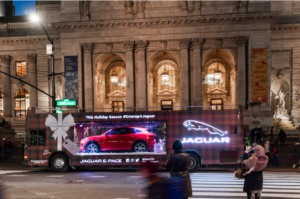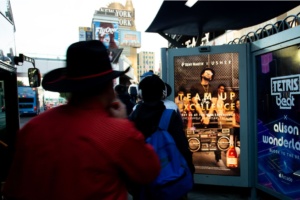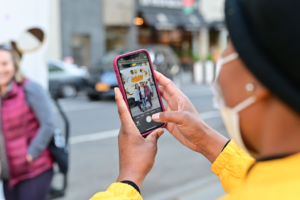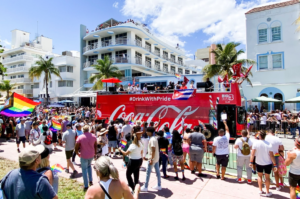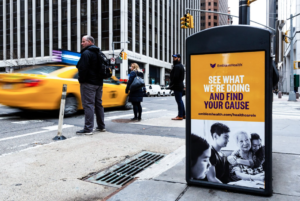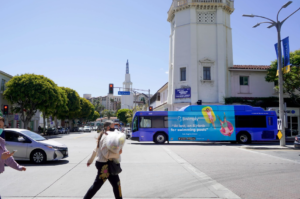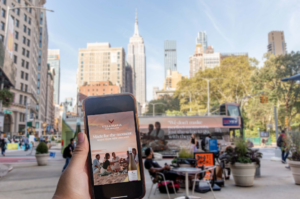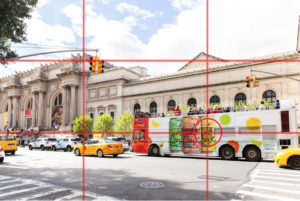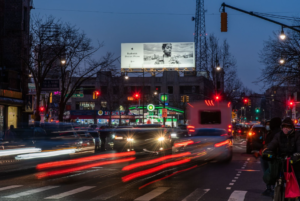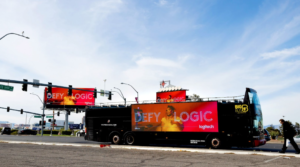By Lisa Staryak – National Photography Manager
Well, hopefully several thousand! In the out-of-home world a photo can go a long way. For clients who often place media in markets located miles away from where they reside, photographs, in some cases, are the only way they get to experience their hard work as it appears in the real world.
Images of our industry’s work are shared across social platforms, websites, through press releases, marketing pieces and of course, slide decks. They serve multiple purposes and are often seen by many. OOH is ultimately a visual medium, existing in the physical realm, so capturing it with artful photography is endlessly valuable.
Thanks to ever evolving technologies, we are able to provide dynamic, beautiful images that showcase brand stories out on the streets of America not only with professional cameras, but even with our mobile phones we carry with us each day. Having said that, it’s all about how you use it.
I’ve been heading up photography at Vector Media for a decade now, and I know what it takes to get a good pic of an OOH placement. Keep reading below for some of my top tips, both technical and theoretical, on how to get the best results.
Level with your audience.
Perspective is one of the key elements to keep in mind while shooting out-of-home media. Photos taken from the viewpoint of the consumer are obviously going to portray a more accurate picture, but that’s not the only benefit. It also allows you to show the long-distance read, and the close-up impact of large format OOH. Speaking of consumers, they’re exactly what we want to see in photos with our media. Large crowds, people enjoying outdoor dining, consumers bustling in and out of stores, all help to breathe life into our images. They add character, feeling and most importantly demonstrate the effectiveness of our medium.
Picture Inception
Eye catching creative, comical copy, or an engaging experiential campaign can all do a great job of eliciting attention from the surrounding public. You know you’ve hit the jackpot when you are able to capture a photo of someone taking a photo of your media! What better way to show the power of out-of-home to generate earned media impressions that could send your campaign impact to the moon.
Location, Location Location
From the Rocky Steps to Rodeo Drive, including iconic landmarks, lively downtown cityscapes, and recognizable signage in your photos help to tell an important story for your clients. Each neighborhood paints a vibrant picture of its inhabitants, visitors and culture. These locations are purposefully and strategically picked by advertisers to target specific lifestyles, tourists, demographics, so show it off!
Slow down
Getting creative with our images can be tough, let’s face it – there are only so many ways you can make out-of-home look glamorous. One way to step up your game and give your photos a more “high-end” look and feel to them is to slow down the shutter speed on your camera. This allows you to focus on your stationary subject, whether it be a billboard, stationery bus or piece of street furniture, and allow passersby and vehicular traffic driving through the frame to fade and swirl into some very cool and artistic looking motion blur. (Extra points for doing this in low light and leveraging a car’s head and tail lights for creativity!)
Speed up!
Not all of our media is fixed in one stationary location. When you find yourself shooting moving vehicles like buses, trains or trolleys you’ll want to make sure your camera is shooting with a high shutter speed. (Similar settings you might also use while catching some action shots of your kids soccer game). To get technical, I’d recommend a minimum of one 500th of a second, aka 1/500, for a tack-sharp image.
A look through the lens.
Wide angle, telephoto zoom or prime, each type of lens you shoot with will drastically change your photo. The glass you’re choosing to use with your camera, to much surprise, will actually affect the final image outcome more than the camera body itself. When shooting out-of-home, though a gut instinct may tell you to choose a wide angle, I’ve found that by shooting with a zoom or prime you can strategically highlight your media as the focal point of your shot by leveraging depth-of-field. The lens compresses everything not in focus giving you that polished professional, blurry background look called “bokeh”.
Where the road leads.
While shooting and framing our shots, it is important to be cognizant of where the viewer’s eye will naturally land. Transit advertising, buses, shelters and billboards are all located on or alongside the road, which if framed improperly can distract from the ad piece. I like to use the tried and true photography method of “the rule of thirds”. With this composition technique, the photographer is creating a mental grid, composed of two vertical and two horizontal lines. Placing the subject at points where the lines intersect will help ensure the viewer’s eye is naturally being drawn there. Shooting in busy dense areas, or visually chaotic locations like the heart of Times Square, can be challenging. By framing with this rule in mind you can ensure the intended subject of the photo is the first thing you notice.
Light it up!
The day doesn’t end when the sun goes down. Many cities become even more alive once the sun sets – think South Beach Miami, and the Theater District in Manhattan after the Broadway shows let out. This means all of our media located in these vibrant areas with bustling nightlife are still getting impressions until the wee hours. What better way to make sure our ads are seen than to light them up. Buses with illuminated embellishments, billboards lit up against the night sky, and bus shelters dotting the streets with their dreamy glow, all take on a slightly different look once dusk hits. Shooting on a tripod can be most helpful when photographing at night, and is how you are able to achieve that dramatic motion blur effect which seems to turn passing car lights into sci-fi looking laser beams. A slow shutter speed, giving you a nice wide open aperture will be your best bet for pics in low light settings. Boosting your ISO to a higher number can help as well, but beware of the grain and lower quality that comes with pushing it too far!
Let’s get Digital.
As technology swiftly advances, there are more opportunities for out-of-home to go digital, like Vector’s exclusive digital transit product, the Digital Double Decker. Many factors play into getting the best looking photos of digital media, from shooting during the optimal time of day, weather, sunlight, and camera settings. As an amateur you may notice when trying to capture a digital screen with a phone or camera you can get pesky black horizontal lines running through the screen. Although today’s DOOH screens are crisp and clear, the display hertz rate can interfere with a digital camera’s sensor, causing those lines. The secret to this is shutter speed, as it must be a little slower than the refresh of the screen so that the lines don’t show up. You’re welcome.
Out of Home as a visual and highly creative medium allows advertisers to reach their ideal audiences and make a memorable impact. These outdoor ads become woven in the fabric of people’s everyday lives, as they are consumed while on the move, dining out, traveling, and experiencing the world. Eye catching and stunning ads can in their own way, be a true work of art. When captured with equally impressive photography, these campaigns can be “liked”, shared and live on for years to come.
